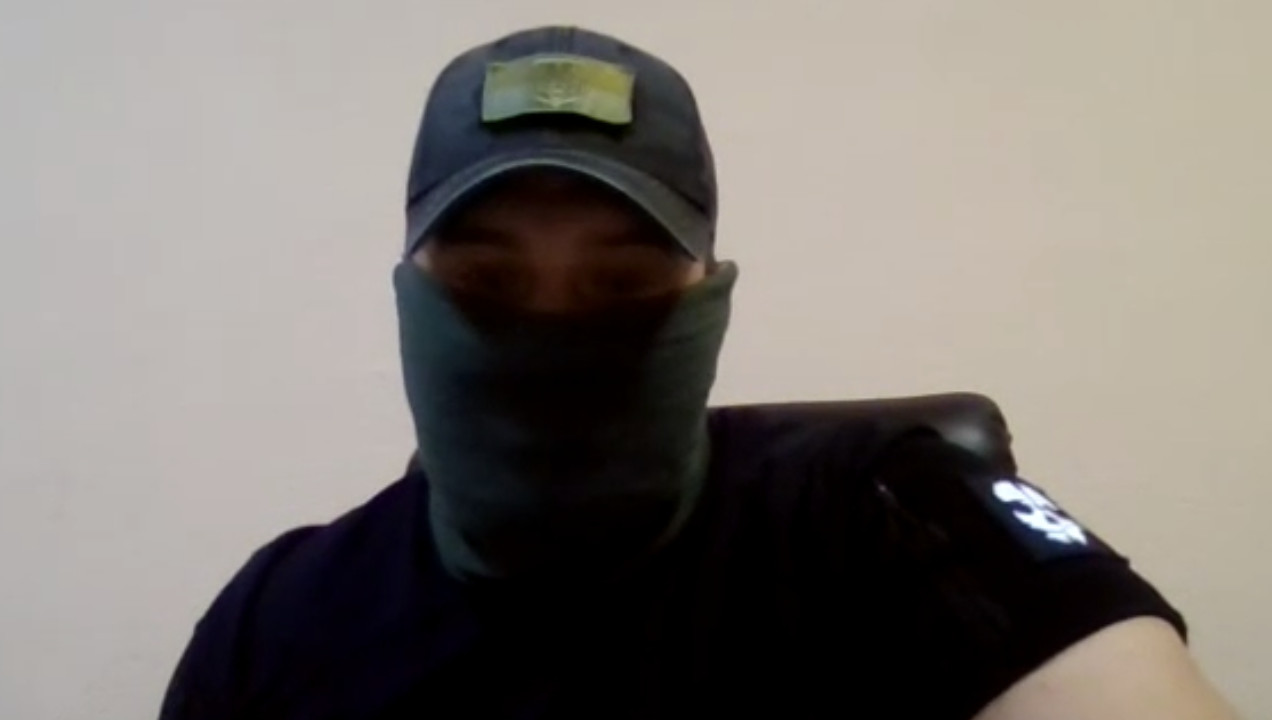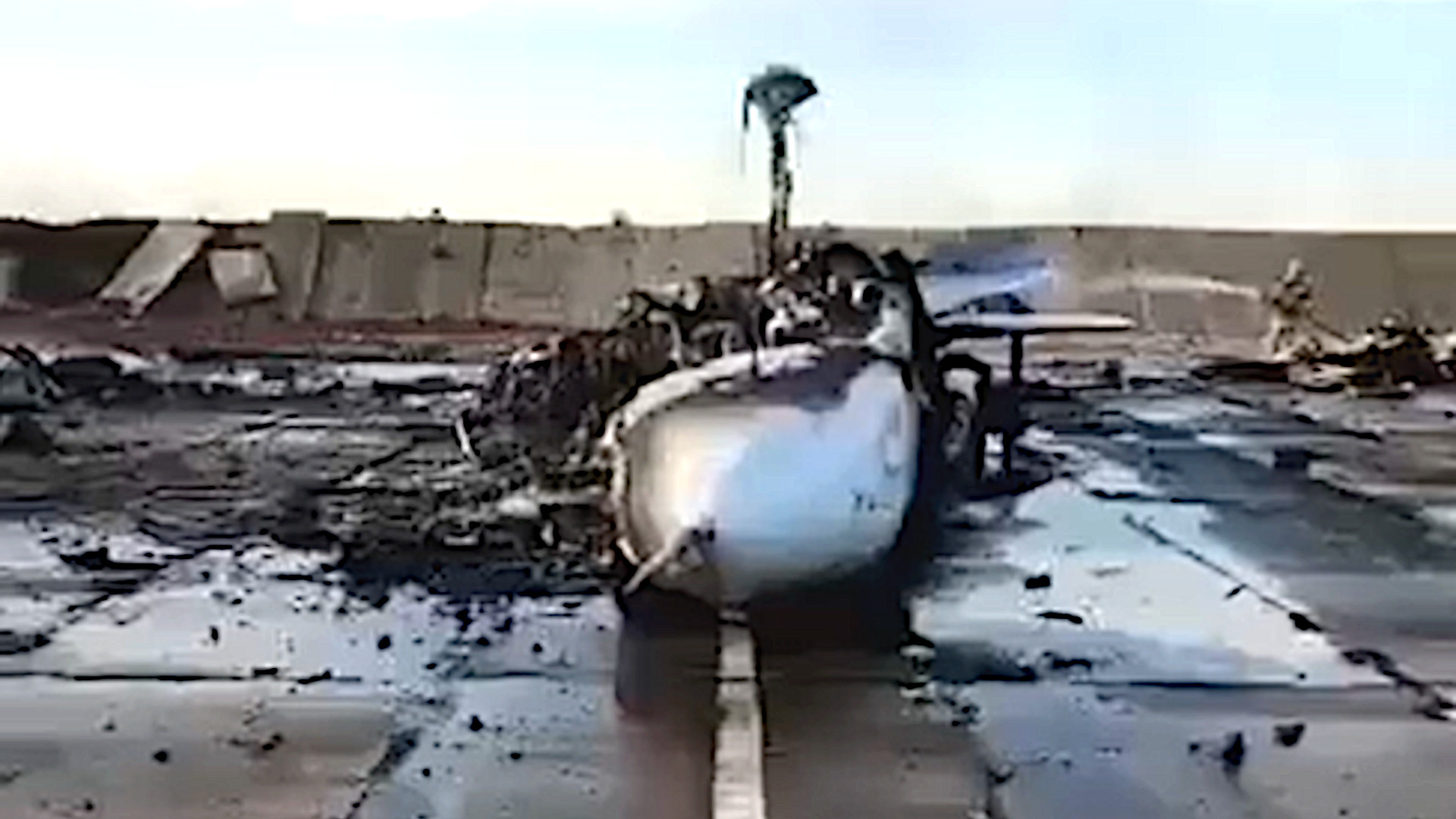Claims continue to swirl surrounding a series of explosions that rocked Russia’s Saki Air Base on the occupied Crimean Peninsula yesterday. Various Ukrainian officials have offered conflicting explanations about what happened. Statements from them, on and off the record, now include flat denials that their country was involved at all, as well as that it was an attack carried out by pro-Ukraine guerrillas or Ukrainian special operations forces, or a strike involving a domestically-developed weapon system. Even reported details about the exact scope and scale of the damage, as well as fatalities and injuries, have varied greatly.
Readers can first get up to speed on what is already known about the incident in The War Zone‘s initial reporting.
The Ukrainian Air Force has now claimed that at least 10 Russian aircraft were destroyed in the incident, up from previous official tallies of seven and then nine. Initial reports indicated that one person had died and 14 more were injured. However, Anton Gerashchenko, an adviser to Ukraine’s Ministry of Internal Affairs, has now reportedly claimed that 60 people were killed in the blasts and more than 100 others were wounded.
Video footage that has emerged on social media in the past 24 hours shows at least one completely burned-out Russian Su-24M Fencer swing-wing combat jet at the base, as well as substantial damage to surrounding areas as a result of the explosions. The main unit at the base is the Russian Navy’s 43rd Independent Naval Attack Aviation Regiment, which flies Su-30 Flanker fighter jets, as well as Su-24s. Il-76s and other aircraft types were present at the time, as well.
For its part, the Russian Ministry of Defense has claimed that the incident was an accident.
It is difficult, if not impossible at present to independently verify these casualty figures that have emerged so far. At the time of writing, no satellite imagery of the base has become publicly available, possibly due to cloud cover, making it difficult to independently assess the damage, as well.
Though the cause of the incident remains unclear, multiple Ukrainian officials have now told various major news outlets that local pro-Ukrainian guerrillas, also often referred to as partisans, were involved in some way. Ukrainian special operations forces on the ground may have participated in some fashion, as well.
“The senior Ukrainian official said the attack involved partisan resistance forces loyal to the government in Kyiv, but he would not disclose whether those forces carried out the attack or assisted regular Ukrainian military units in targeting the base, as has sometimes occurred in other Russian-occupied territories,” according to one report from The New York Times. “To reach targets deep behind enemy lines, Ukraine has increasingly turned to guerrillas in Russian-occupied territories, officials said. Partisans, for instance, have helped Ukrainian forces target Russian bases and ammunition depots in the Kherson Region, Ukrainian officials say.”
A separate report from The Washington Post said that an anonymous Ukrainian official had told the newspaper that special operations forces were responsible for the blasts, but also indicated that these individuals may have actually been partisans. “The official, who spoke on the condition of anonymity because they were not authorized to speak publicly on the matter, did not disclose details of how Tuesday’s attack was carried out,” the outlet added.
Mykhailo Podolyak, an adviser to Ukrainian President Volodymyr Zelensky, had also denied direct Ukrainian involvement in the incident in an interview with Dozhd, an independent Russian-language television network headquartered in Latvia. This could further point to partisan involvement, or simply be intended to obfuscate the situation.
It is certainly known that the Ukrainian military and intelligence services have units of varying degrees of formalization that are tasked with conducting raids, sabotage, and reconnaissance deep behind enemy lines, as well as across the border inside Russia. The War Zone was able to conduct interviews with individuals from one of these groups, known as the Shaman Battalion, which you can find here.

Claims that guerrillas were responsible, even in part, for the explosions at Saki Air Base could fit with the local Russian government’s decision to subsequently raise the official terrorist threat level for the region.
Whether or not pro-Ukrainian elements, possibly working alongside Ukrainian government forces, were involved in any way, if the incident was an attack or strike, its exact mechanism remains unknown. Much of the public discourse about how the Ukrainians may have carried this out has centered on stand-off rocket or missile strikes. Ukrainian forces are not publicly known to have any operational ships with suitable weapons or ground-based surface-to-surface munitions with sufficient range to have carried out such a strike. As such, discussions have turned to the possibility of secret foreign deliveries of suitable weapons, such as the U.S.-made Army Tactical Missile System (ATACMS) short-range ballistic missile, or the possibility of a previously unknown domestically-developed capability, as you can read more about here.
American and Ukrainian officials have also told various media outlets that what happened at Saki Air Base was an attack of some kind and that it involved domestically-developed weaponry or at least munitions not supplied by the U.S. government. These explanations are, of course, not mutually exclusive to ones that involve partisans or special operations forces.
“A Ukrainian presidential adviser, Oleksiy Arestovych, cryptically said that the blasts were either caused by a Ukrainian-made long-range weapon or the work of Ukrainian guerrillas operating in Crimea,” according to another report from The Washington Post.
The reports surrounding partisans and special operations forces, in fact, could well point to a stand-in strike of some kind, rather than a stand-off one. For instance, infiltrators, whether directly linked to the Ukrainian government or not, could have gotten close enough to Saki Air Base to launch small drones carrying improvised munitions. Even small bomblets could have been enough to trigger a massive conflagration if they managed to hit fuel or munitions stockpiles.
We know that Ukrainian forces, including volunteer elements, have been employing small drones with improvised armament extensively. In addition, the utilization of these kinds of unmanned aerial systems in this instance would be very much in line with what we know about a fatal drone strike right at the end of last month on the Russian Navy’s Black Sea Fleet headquarters in Sevastopol, also in occupied Crimea.
As The War Zone wrote after that incident:
However, perhaps even more concerning for Russia is an apparent new wave of guerilla warfare and especially targeted assassination carried out by pro-Ukrainian partisans. There has already been a string of murders and explosions in Russian-held territory, especially in southern Ukraine. With plenty of experience of this kind of warfare in the Caucasus, Moscow will be well aware of the potential for disruption offered by partisan resistance groups. Still, if Russia’s invasion was to drag on, as it has, an extremely bloody insurgency was all but certain.
Drones have become a tool of choice for many of these types of activities, including targeted assassinations against everyone from rival drug cartel members to heads of state, to strikes on strategic assets deep into foreign territory.
Once again, it’s not clear if yesterday’s drone attack was the work of resistance fighters operating in Russian-held territory, or Ukrainian military or security service elements operating behind enemy lines. It could also have been a combination of the two. Either way, attacks like this make it abundantly clear to Russia that it’s facing many different threats as it seeks to preserve the territorial gains it has already made, while at the same time redeploying forces to withstand renewed Ukrainian offensives in different regions. But most of all, it sends the chilling message that Russian forces are under threat even in uncontested areas, including at the very heart of the Black Sea Fleet itself. The method is also key. These types of drone strikes have a very low barrier of entry, are extremely hard to defend against, and finding the perpetrators is also extremely challenging.
Regardless of whether or not what happened at Saki Air Base was indeed a Ukrainian attack or strike of some kind, it already appears to be having notable second-order impacts. This includes a large exodus of Russians from Crimea, including tourists who apparently previously felt safe enough to vacation on the occupied peninsula despite the war raging nearby.
Beach goers were among the first yesterday to record the blasts at the Russian base.
Despite not explicitly taking responsibility, the Ukrainian government has not shied away from seizing on the obvious propaganda value of what happened at Saki, either.
“This Russian war against Ukraine and against all of free Europe began with Crimea and must end with Crimea – its liberation,” President Zelensky said in his regular nightly address after the incident.
Other Ukrainian officials have said that more of these incidents are likely to come and have suggested that this is the opening salvo in a broader campaign to liberate occupied areas in the southeastern end of the country. Ukraine’s government has made no secret of its ambitions to recapture the strategic southern city of Kherson, and potentially push further south, before the end of the year.
All told, while it very much remains uncertain exactly what happened at Saki Air Base yesterday, is certainly embarrassing for Russian authorities and comes at a time when the war in Ukraine’s south is very much heating up.
Update:
Satellite imagery showing the aftermath of the explosions at Saki Air Base yesterday has now become available. You can find The War Zone’s analysis of what can be seen in an image taken of the base today that we obtained from Planet Labs here.
Contact the author: joe@thedrive.com
